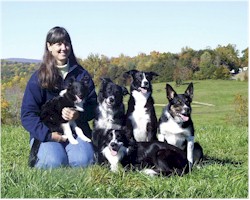10th Pole Syndrome
|
|
|
|
Weave weave weave whoops!
|
|
ē Handler positioning ahead of the dog helps. I usually position myself one pole ahead of the dog, and close to the dog, so that it can see the 11th pole and me. ē I teach the dog to accept a hand signal that redirects the dog back into the poles at pole 11 and 12. Being able to get the dogís focus down and on the poles themselves helps (away from the handlerís face). ē I teach the dog an Easy command (that is, slow down and be careful) away from the equipment and then I use it about pole 9 to help the dog realize he should no longer bounce through the poles with muscle memoryó instead, he should think about whatís coming up. ē Handler motion using a path that converges toward the dog while in the poles may help this problem as well. I find that beginner dogs donít usually have the problem because they are thinking very hard about the poles. Experienced dogs seem to learn to tune out the handler and look ahead for those last two poles. It is the dogs somewhere in between, those that think, 'Hey, Iíve got it!' and indeed, might just now be discovering their rhythm and speed; those are the ones most likely to have the problem. Most work through it with help. However, I have seen cases where I think a similar situation exists in experienced dogs. Often, if you place an obstacle or an object near the end of the weaves, the dog will pop out. I donít think it is necessarily the temptation of the obstacle. I think it is the proximity of the object (see Figure 3). If you place a wall or a ring barrier or something similar at the end of the poles, often even experienced dogs will pop out. I believe the wall becomes overwhelming in their field of vision, and what they see as they near the end of the poles is the obstruction approaching, not the last two weave poles. A similar situation arises if the poles are leaning the wrong way. The dog just doesnít even see the pole (see Figure 4). |
 Figure 1 Handler even with dog, i.e. dog cannot see handler and the last two poles and pops out thinking he's done. Arrows depict dog's field of view.
|
Now, if I watch a class of high-level dogs, and dog after dog is popping out at pole 10, I will resort to the same measures I use with my inexperienced dog to help him see those last two poles and prevent a fault in my dogís performance.
So if your dog is popping out near the end of the poles and all the potential causes have been ruled out and the reason is still unapparent, your dog may be suffering from '10th Pole Syndrome.''
 About
the author...
About
the author...
Linda Mecklenburg is one of the leading
handlers in the USA. She has represented the USA in international competition on seven
different occasions with three different dogs.
In 2001 she and her BC Awesome were members of USA team that became the gold medal winning FCI Standard Team World Champions. Awesome also placed eighth in the Standard Individual competition, thus having the best combined performance of all dogs at the FCI World Championships that year.
Linda teaches agility full-time at her Awesome Paws Agility Center in central Ohio, USA. She can be reached by email at awesomepaws@aol.com.
Clean Run Productions, LLC is dedicated exclusively to the sport of dog agility. It publishes America's #1 monthly magazine on agility training and have published 15 books on the subject with more in the works. They also offer a broad spectrum of training accessories as well as fun and unique products for your performance dog.
From Wendi Watson...
10th pole syndrome ≠ very interesting. What drew my attention was the great pic of
the smooth fox terrier (I think) with flapping or prick ears. We aren't so advanced for it to
be a problem! The breed is so rarely seen in England, especially in agility.
(16/12/02)
|
[bottom.htm] © Copyright Agilitynet |